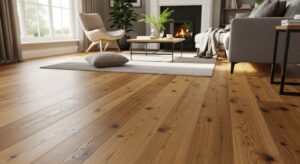Hardwood flooring is a popular choice among homeowners due to its durability, aesthetic appeal, and potential to increase property value. If you’re considering upgrading your home with hardwood floors, one question you may be asking is: Can I install hardwood floors over existing floors? The short answer is yes, in many cases, it is possible, but there are several important factors to consider before doing so. This article explores the pros, cons, necessary preparations, and types of existing floors that can support hardwood flooring.
Why Consider Installing Over Existing Floors?
Removing old flooring can be labor-intensive, time-consuming, and costly. By installing hardwood over existing floors, you can:
- Save Time and Money: Avoid demolition and disposal costs.
- Reduce Mess: Eliminate the dust and debris associated with floor removal.
- Raise Floor Height Strategically: In some cases, raising the floor height slightly can help transition between rooms more smoothly or align with cabinetry and fixtures.
However, skipping the removal step is not always a viable or advisable option. The condition and type of the existing floor play a crucial role in determining if hardwood can be laid over it.
Types of Hardwood Flooring: Which Can Be Installed Over Existing Floors?
Not all hardwood flooring is created equal. There are two main types of hardwood flooring, and each behaves differently when installed over existing floors:
Solid Hardwood Flooring
Solid hardwood is made from a single piece of wood. It’s thick, durable, and can be sanded and refinished multiple times. However, it is more sensitive to moisture and temperature changes, and typically requires a subfloor made of plywood or another wood product.
- Installation Method: Generally nailed or stapled down, not ideal for installing directly over concrete or tile.
Best Substrates: Existing wood floors, plywood, or oriented strand board (OSB) in good condition.
Engineered Hardwood Flooring
Engineered hardwood is constructed with a top veneer of real wood and layers of plywood beneath. It’s more stable than solid hardwood and can handle moisture better.
- Installation Method: Can be glued, nailed, or installed as a floating floor.
- Best Substrates: Tile, vinyl, linoleum, concrete, and existing hardwood.
Assessing Your Existing Floor
Before you begin, evaluate your current floor carefully. Ask yourself:
Is the Floor Level?
Hardwood flooring requires a flat surface. Uneven floors can cause gaps, squeaks, or even structural failure. Use a level to check for dips or high spots greater than 3/16″ over a 10-foot span.
Solution: You may need to sand high spots or use a self-leveling compound for dips.
Is the Floor Structurally Sound?
If the existing floor is rotted, unstable, or damaged, it’s best to remove it. A solid foundation is very important to prevent movement and creaking.
Solution: Repair damaged areas or replace sections before installation.
What’s the Height Impact?
Installing over an existing floor adds height, which can affect door clearances, thresholds, and transitions between rooms.
Solution: Trim doors, adjust baseboards, or add transition strips as needed.
Also Read: Do Hardwood Floors Expand and Contract with the Seasons?
Installing Hardwood Over Different Types of Existing Floors
Let’s break down how hardwood installation works with various types of existing flooring:
Over Existing Hardwood
This is generally the easiest scenario. If the old hardwood is level, dry, and in good condition, new hardwood can be nailed or glued over it.
Best Practices:
- Fasten loose boards.
- Clean and lightly sand for better adhesion if gluing.
- Lay new planks perpendicular to existing ones for stability.
Over Laminate Flooring
Laminate is often too soft and unstable to serve as a base for hardwood.
- Recommendation: Remove the laminate before installing hardwood.
Over Tile
Tile is hard and level, making it a decent substrate for engineered hardwood. Solid hardwood is not recommended directly over tile due to nail penetration issues.
- Best Practices:
- Ensure tiles are firmly set and the surface is level.
- Use a high-quality adhesive for glue-down installation.
- Floating engineered floors work well over tile with underlayment.
Over Vinyl or Linoleum
Thin vinyl or linoleum in good condition can sometimes remain in place, especially if installing a floating engineered hardwood.
Best Practices:
- Ensure the flooring is glued down securely and is not peeling.
- Avoid using over-cushioned or padded vinyl.
Over Concrete
Concrete slabs require special considerations. Solid hardwood is not recommended directly on concrete, especially below grade (e.g., in basements).
Best Practices:
- Use engineered hardwood.
- Test for moisture using a moisture meter.
- Apply a vapor barrier and glue down or float the floor.
Installation Methods for Hardwood Over Existing Floors
There are three common installation methods for hardwood flooring, each suitable for different situations:
Nail-Down Installation
- Requires a wooden subfloor or old hardwood.
- Not suitable over concrete, tile, or vinyl.
Glue-Down Installation
- Works well for engineered hardwood over tile or concrete.
- Requires a strong adhesive and a clean, level surface.
Floating Floor Installation
- Engineered hardwood planks lock together and “float” over the surface.
- Ideal for going over tile, vinyl, or concrete.
- Requires underlayment for sound and moisture control.
Ready To Install Hardwood Flooring Over the Existing Floor?
So, are you interested in installing hardwood flooring over your existing floor? Reach out to Floorika Fine Hardwood. We have been in this industry for over a decade and install all types of hardwood floors. Our team is well-trained and experienced. They have the right tools and equipment to complete the job efficiently and quickly.
Don’t let newbies damage your floor. Contact us and let our experts provide the best flooring treatment.




